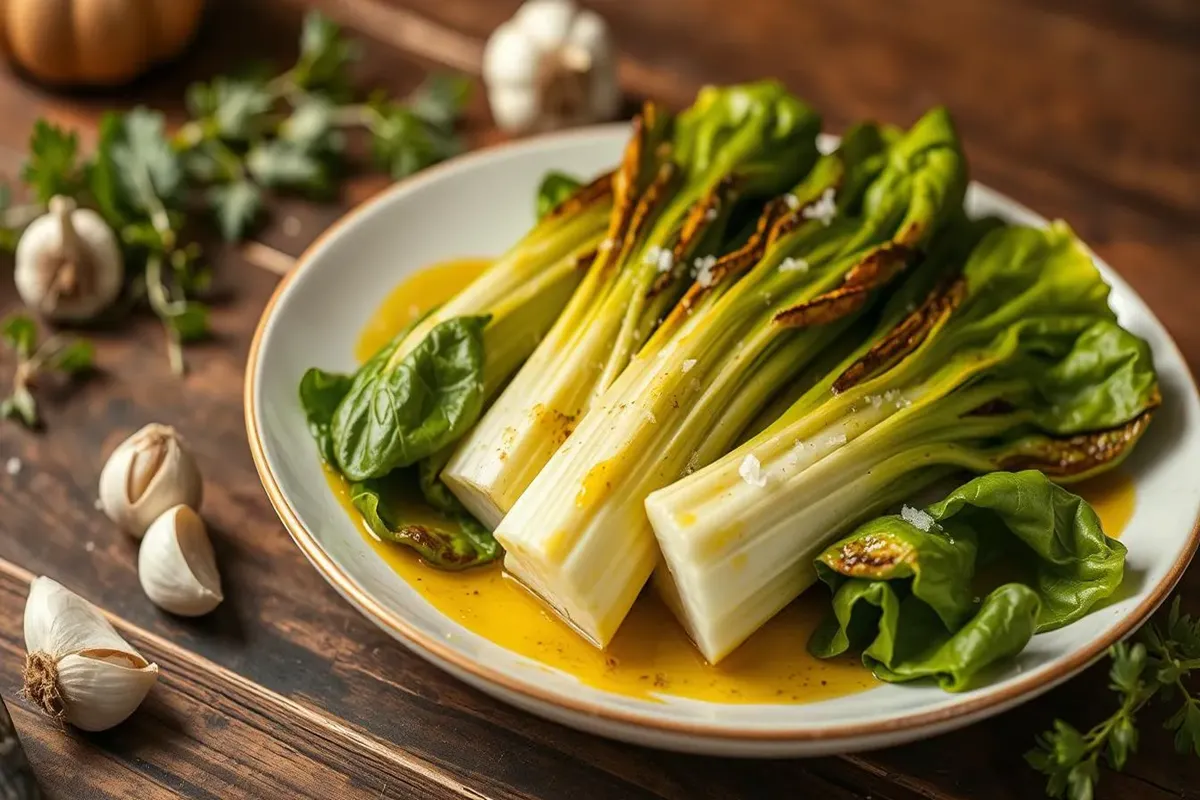Roasted bok choy is a tasty and nutritious side dish. It’s gaining popularity in modern cooking for its unique taste and health perks. It’s a great pick for anyone wanting to spice up their meals.
Key Takeaways
- Roasted bok choy is a healthy side dish option
- It’s a versatile vegetable that can be prepared in various ways
- Roasted bok choy is rich in nutrients and has numerous health benefits
- It’s a popular choice in modern cuisine due to its unique flavor
- Roasted bok choy can be paired with a variety of dishes for a healthy meal
- It’s an excellent choice for those looking to add some variety to their meals
What is Bok Choy and Its Origins
Bok choy is a favorite in many kitchens. It has a rich history and comes in various types. This makes it loved by chefs and home cooks.
History of Bok Choy
Bok choy comes from ancient China. It was grown for its tender leaves and crunchy stalks. Over time, it became a key part of Chinese cuisine. It’s valued for its adaptability and health benefits.
Different Varieties of Bok Choy
There are many bok choy varieties, each special in its own way:
- Shanghai Bok Choy: Smaller with dark green leaves and thick stems.
- Baby Bok Choy: Milder in flavor, great for quick cooking.
- Tat Cho Bok Choy: A more ornamental variety with vibrant colors.
Why Bok Choy is Popular in Modern Cuisine
Bok choy is loved for its versatility and nutritional value. It’s perfect for salads, stir-fries, and roasted dishes. This makes it a top choice for healthy meals.
Nutritional Benefits of Bok Choy
Bok choy is a superfood, full of bok choy nutrition that boosts health. It’s low in calories, perfect for any diet.
- Vitamin A: Helps your eyes and immune system.
- Vitamin C: Keeps your immune system strong and helps with collagen.
- Vitamin K: Good for bones and blood clotting.
- Fiber: Keeps your digestive system healthy and helps with weight.
Bok choy’s vitamins are key to health benefits like better eyes, stronger bones, and a strong immune system. Adding bok choy to meals keeps these functions going without extra calories.
Essential Ingredients for Roasted Bok Choy
To make perfect roasted bok choy, start with bok choy selection. Pick fresh, crisp bok choy with bright green leaves and firm stems. Make sure the bases are intact and free from yellowing or wilting. Clean the bok choy by rinsing under cold water and trimming any tough ends.
Selecting the Perfect Bok Choy
For bok choy selection, choose heads that are heavy for their size, showing freshness. The leaves should be bright green and tightly packed without any signs of browning. Avoid bok choy that appears limp or has spotted leaves.
Seasoning Options
Boost the natural flavors with various roasting bok choy ingredients. Here are some common ones:
- Olive oil or sesame oil for a rich base
- Garlic and ginger for an aromatic touch
- Salt and pepper to taste
- Red pepper flakes for a bit of heat
- Lemon juice or soy sauce for added depth
Required Kitchen Tools
Roasting bok choy is simple and doesn’t need special tools. Make sure you have:
- Oven and baking sheet
- Mixing bowl
- Knife and cutting board
- Measuring spoons
- Cooking brush for applying oil
| Ingredient | Purpose |
|---|---|
| Olive Oil | Adds richness and helps in roasting |
| Garlic | Provides aromatic flavor |
| Red Pepper Flakes | Introduces a spicy kick |
| Salt & Pepper | Enhances overall taste |
| Lemon Juice | Offers a tangy contrast |
How to Prepare Roasted Bok Choy
Preparing bok choy for roasting is easy and brings out its natural flavors. Start by rinsing the bok choy under cold water to remove any dirt. Make sure each head is clean by separating and washing the leaves thoroughly.
Next, trim the base of the bok choy and cut them into halves or quarters, depending on the size. Uniform cuts are essential in bok choy preparation. They ensure even cooking and the perfect texture.
After cutting, you can choose to marinate the bok choy for added flavor. In a large bowl, toss the pieces with olive oil, minced garlic, and your favorite seasonings. Make sure each leaf is evenly coated to enhance the taste.
- Wash and separate the bok choy leaves.
- Trim the stems and cut into desired sizes.
- Toss with oil and seasonings for marinating.
- Arrange on a baking sheet without overcrowding.
With your bok choy prepared, it’s ready to move on to roasting. This simple bok choy preparation makes a delicious and healthy addition to any meal.
Perfect Roasting Techniques
Mastering bok choy roasting techniques ensures your dish is flavorful and perfectly cooked every time.
Temperature Guidelines
Set your oven to 425°F (220°C) for optimal roasting bok choy. This temperature allows the greens to wilt slightly while the stems become tender without burning.
Timing and Doneness
Roast bok choy for 15-20 minutes. Look for crispy edges and vibrant green leaves. The stems should be tender but with some crunch, showing perfect doneness.
Tips for Achieving the Perfect Char
- Place the bok choy on the center rack for even heat distribution.
- Use a baking sheet lined with parchment to prevent sticking.
- Broil for the last 2-3 minutes to enhance the char, keeping a close eye to avoid burning.
Common Mistakes to Avoid When Roasting Bok Choy
Roasting bok choy can make it a tasty side dish. But, it’s important to avoid common mistakes. Here are some bok choy roasting mistakes to watch out for:
- Overcooking: If you leave bok choy in the oven too long, it can become soggy. Aim for crisp-tender leaves.
- Using Too Much Oil: Too much oil can make the bok choy greasy. Just use enough to lightly coat it.
- Not Seasoning Properly: Not enough seasoning can make the dish taste bland. Make sure to add enough salt and your favorite spices.
- Uneven Cutting: Cutting bok choy unevenly can cause some pieces to be overcooked while others are undercooked. Try to chop it uniformly.
By following these bok choy cooking tips, you can improve the taste and texture of your roasted bok choy. It will be a highlight of any meal.
| Mistake | How to Avoid |
|---|---|
| Overcooking | Check bok choy at regular intervals to achieve crisp-tender leaves. |
| Using Too Much Oil | Apply a light layer of oil to coat the bok choy evenly. |
| Not Seasoning Properly | Add adequate salt and spices to enhance flavor. |
| Uneven Cutting | Chop bok choy into uniform pieces for consistent cooking. |
Flavor Variations and Seasoning Ideas
Make your roasted bok choy even better with simple yet tasty seasonings. Trying out different flavors can elevate this healthy side dish.
Asian-Inspired Seasonings
Add soy sauce and fresh ginger to your bok choy. Sesame oil and sesame seeds bring a nutty flavor, making it savory and aromatic.
Mediterranean Variations
For a zesty taste, mix olive oil, lemon juice, and garlic. Oregano or thyme adds to the bok choy’s natural flavor, making it fresh and lively.
Spicy Options
Love spicy food? Try chili flakes or sriracha. A bit of honey can soften the heat, giving it a sweet and spicy taste.
Serving Suggestions and Pairings
Serving roasted bok choy adds a delightful crunch and vibrant color to any meal. It pairs wonderfully with a variety of proteins.
Grilled chicken complements the mild flavor of bok choy, creating a balanced and satisfying dish. For seafood lovers, grilled salmon or tender shrimp work perfectly.
Bok choy food pairings also shine in grain bowls. Combine it with quinoa, brown rice, or farro for a nutritious and filling meal. Add some roasted vegetables and a tangy dressing to enhance the flavors.
For those looking to keep it simple, serve roasted bok choy as a standalone side dish. Garnish with toasted sesame seeds or a squeeze of lemon to make the presentation appealing.
Experiment with different pairings to discover your favorite combinations. Whether you’re hosting a dinner or preparing a quick weeknight meal, serving roasted bok choy can elevate your culinary creations.
Conclusion: Making Roasted Bok Choy a Regular Part of Your Menu
Roasted bok choy is a great choice for any meal. It’s tasty and good for you, full of vitamins A, C, and K. It’s easy to make, needing just a few ingredients and little time.
Trying out different bok choy recipes keeps your meals interesting. You can add Asian flavors, Mediterranean tastes, or a bit of spice. Pair it with chicken, tofu, quinoa, or brown rice for a complete meal.
Adding roasted bok choy to your meals makes them healthier and more enjoyable. It’s a versatile green that can change your eating habits for the better.
For more Lunch recipes, check out our Lunch Recipes for more ideas.
FAQ
What are the nutritional benefits of roasted bok choy?
Roasted bok choy is full of vitamins A, C, and K. It’s also rich in fiber and low in calories. This makes it a great choice for a healthy side dish that boosts eye health, bone strength, and the immune system.
How do I select the best bok choy for roasting?
Pick fresh bok choy with bright green leaves and firm stalks. Look for heads that are tight and not yellow or wilted. Fresh bok choy gives the best taste and texture when roasted.
What are some common mistakes to avoid when roasting bok choy?
To get perfectly roasted bok choy, don’t overcook it. Also, use just the right amount of oil and season it well. Overcooking makes it soggy, too much oil hides its taste, and not enough seasoning makes it bland.
Can I use different seasoning options for roasted bok choy?
Yes! Roasted bok choy goes well with many flavors. Try Asian flavors like soy sauce and ginger, or Mediterranean with olive oil and lemon. For a spicy twist, add chili flakes or sriracha.
What kitchen tools are essential for roasting bok choy?
You don’t need special tools to roast bok choy. A baking sheet, mixing bowl, and sharp knife for cutting are all you need. An oven is the main tool for roasting.
How long should I roast bok choy to achieve the perfect texture?
Roast bok choy at 400°F (200°C) for 20-25 minutes. This time makes the leaves crispy and the stalks tender. Watch them closely to avoid burning and get a nice char.
What are some delicious flavor variations for roasted bok choy?
You can try many flavors for roasted bok choy. Use Asian seasonings like soy and ginger, Mediterranean with olive oil and lemon, or spicy with chili flakes or sriracha. Each adds a unique taste.
What can I serve roasted bok choy with?
Roasted bok choy goes great with grilled chicken or fish. It also fits well in grain bowls and as a side dish. For a nice touch, add sesame seeds or a squeeze of lemon.
How can I incorporate roasted bok choy into my regular meals?
Make roasted bok choy a regular part of your meals by trying different seasonings and pairings. It’s versatile and can be a side, part of a salad, or in grain bowls. Its ease makes it a great choice for healthy eating.
Why is bok choy becoming popular in modern cuisine?
Bok choy’s growing popularity comes from its versatility, nutritional value, and taste. It’s easy to prepare, fits many flavors, and appeals to those looking for tasty and healthy side dishes.

